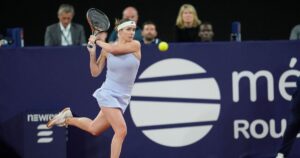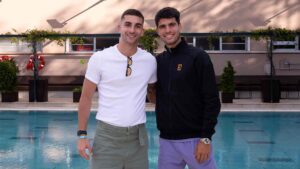
For the better part of three years, only two players have held the Hologic WTA’s No.1 ranking. That fierce, furious competition between Iga Swiatek and Aryna Sabalenka has elevated both their games and kept them on top. They have won seven of the past 11 Grand Slam singles titles, including three of four in 2024.
In business, it’s called dynamic tension. You can see it in Silicon Valley, where billion-dollar-behemoths Apple and Google — two of the world’s most successful tech companies — are separated by less than a 10-minute drive.
“I actually love this — I’m a huge fan to have this,” Anton Dubrov, Sabalenka’s coach, recently said. “For me, the biggest and most exciting is when you overcome the person in front.
“I think it’s harder to be first, but at the same time it also helps you improve even more because you understand that someone’s always behind you. You feel much more pressure, but this is also where you can show, under that pressure, doing the right things, how you can be the real No.1.”
Heading into this week’s Australian Open, it’s Sabalenka.
Swiatek held No.1 for 75 weeks after Ashleigh Barty announced her retirement in April 2022. Sabalenka snatched it for the first time after the 2023 US Open, but gave it back eight weeks later when Swiatek won her last 11 matches of the year — including a pivotal straight-sets semifinal decision over Sabalenka at the WTA Finals in Cancun.
After a 50-week run, Swiatek was overcome again at the end of the 2024 season when Sabalenka won 20 of 21 matches, taking titles in Cincinnati, New York at the US Open and Wuhan. You could see it coming after Sabalenka’s straight-sets win over Swiatek in the Cincinnati semifinals.
“She won two Grand Slams so, obviously, the results are there,” Swiatek said of Sabalenka. “Missing Wimbledon for sure, must have been frustrating. But I think she was able to play great tennis in the US Open swing because she was more fresh than all of us.
“But still, you need a lot of work to try to convert this time into something positive. So I think she did that pretty well. And, yeah, she’s for sure, progressing.”
Publicly the players have been increasingly generous with their praise for each other. Their spirited competition for No.1, their mutual respect has helped lift their games, as well as the visibility of the Hologic WTA Tour. Their wild match in the Madrid final — won by Swiatek 7-5, 4-6, 7-6 (7) — was voted the 2024 WTA Match of the Year.
“I thought we have to stay together and have fun and just enjoy our rivalry, not be too tough on each other,” Sabalenka said. “Since that, we already practiced a couple of times.
“Then I was doing fitness after our hit. She was like, ‘I can join you guys.’ We filmed it and post it. It’s been becoming more chill between us, too. I have to say she’s really nice person. It was fun getting to know each other.”
The ever-evolving arms race
Sabalenka actually began the 2022 season as the No.2 player behind Barty, but Swiatek, on the strength of titles in Doha and Indian Wells, was No.2 when the affable Australian decided to retire.
One reason Sabalenka didn’t catch Swiatek earlier was her sometimes spotty service game. After a tour-leading 428 double faults (nearly eight per match), Sabalenka brought in a technical expert and cut that number nearly in half. She broke through at the 2023 Australian Open, winning her first major singles title, and repeated again in Melbourne last year.
“I just feel like her serving used to feel like it would maybe always go off at some point,” Jessica Pegula said. “But now it’s been clutch in all these tough moments, which is something we’re all going to, unfortunately have to deal with for the next few years.”
Sabalenka’s forehand has always been lethal, but now it lands more often under pressure. There is a growing consistency in her point construction and she’s made a conscious decision to move forward more often and employ more drop shots. Most important, she’s learned to control her emotions when things get squirrely.
“She’s become such a more complete player,” Pegula said. “It seems like mentally she’s just dialed in and has figured it out, which used to be her biggest liability at times has become her best weapon on the court.
“Iga’s pushed us to be better. Now [Aryna’s] kind of stepped it up and showing, `Hey, now I’m pushing everybody else to be better.’”
Zheng Qinwen echoed Pegula’s sentiments
“Both Slams that she won [in 2024]I lost against her on the way,” Zheng said. “Which means that I have to be able to beat her. And I’m quite excited for that day.”
Work to do
After Sabalenka won last year’s Australian Open, Swiatek dominated for the next four months, winning four WTA 1000 titles — Doha, Indian Wells, Madrid and Rome — beating Sabalenka in both clay finals. She followed that up with her fourth Roland Garros championship in five years.
And then, for the next five months, Swiatek did not win a tournament. That’s not to say she wasn’t effective. Swiatek won the bronze medal in Olympic singles and reached the semifinals in Cincinnati and the quarters at the US Open. She skipped the WTA 1000 events in Toronto, Beijing and Wuhan.
When she arrived in Riyadh after a two-month break, Swiatek had a new coach, Wim Fissette, and an extensive wish list of upgrades.
“I think it’s kind of obvious,” Swiatek told reporters. “I for sure want to improve my serve, as I’ve been doing for past years. I feel like I still need to continue that.
“For sure I’m not a complete player. I think tactically there are many ways I could go and have more variety on court. Wim has some nice ideas.”
Swiatek holds a decisive 8-4 head-to-head advantage, but looking closer, it’s a 5-1 edge on clay and 3-all on hard courts. On slower courts, when Swiatek has time to set up, she’s more dangerous. On faster surfaces, Sabalenka’s power levels the field.
Only five players currently active have been the year-end No.1 — and Sabalenka, 26, and Swiatek, 23, are the only ones close to the prime of their careers. Going forward, it should be a fascinating back and forth. And soon, they could be challenged by Zheng, 22, and the 20-year-old Gauff.
After her terrific run late in the season, Sabalenka seemed to hit a wall in Riyadh, losing to Gauff in the semifinals. That didn’t dampen her enthusiasm for the coming season.
“Super excited for the next year,” Sabalenka said. “Just want to push myself in those extra, extra moments I had this season, and I didn’t close matches.
Which one week into the 2025 season, she has. Sabalenka won her first event of the year, at the Brisbane International, her 18th career title.
What’s next? Dubrov, her coach of five years, knows. He offers Novak Djokovic as an example of an exemplary frontrunner. Djokovic pursued Roger Federer and Rafael Nadal for years before overtaking them. Now he’s the all-time men’s leader with 24 Grand Slam singles titles.
“It was like it was three years that he was unbeatable and unbelievable,” Dubrov said. “And you’re just inspired by his story because there’s no one he’s chasing. He’s the one who’s the leader all the time. Like you have to run the marathon always in front.”
Can Sabalenka do that?
“I hope so,” Dubrov said. “That’s what we try to work on, trying to get her not thinking about being No.1. What you have to do — you’re kind of chasing your own shadow that’s in front of you.
“And you have to try to catch it.”
Source: https://www.wtatennis.com/news/4195797/how-sabalenka-and-swiatek-are-pushing-the-limits-at-the-top-of-the-wta


